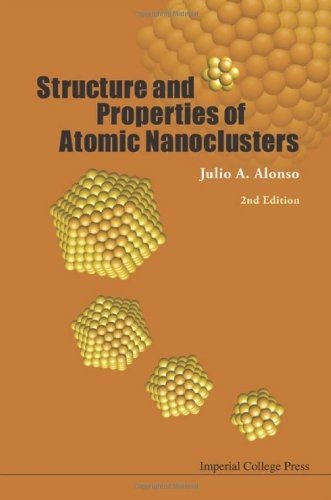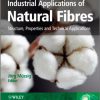(EBOOK PDF)Structure And Properties Of Atomic Nanoclusters 2nd Edition by Julio Alonso 9781848167346 1848167342 full chapters
$50.00 Original price was: $50.00.$35.00Current price is: $35.00.
Structure And Properties Of Atomic Nanoclusters 2nd Edition by Julio A. Alonso – Ebook PDF Instant Download/Delivery: 9781848167346, 1848167342
Full download Structure And Properties Of Atomic Nanoclusters 2nd Edition after payment

Product details:
• ISBN 10:1848167342
• ISBN 13:9781848167346
• Author:Julio A. Alonso
Structure And Properties Of Atomic Nanoclusters (2nd Edition)
Atomic clusters are aggregates of atoms containing a few to several thousand atoms. Due to the small size of these pieces of matter, the properties of atomic clusters in general are different from those of the corresponding material in the macroscopic bulk phase. This monograph presents the main developments of atomic clusters and the current status of the field. The book treats different types of clusters with very different properties: clusters in which the atoms or molecules are tied by weak van der Waals interactions, metallic clusters, clusters of ionic materials, and network clusters made of typical covalent elements. It includes methods of experimental cluster synthesis as well as the structural, electronic, thermodynamic and magnetic properties of clusters, covering both experiments and the theoretical work that has led to our present understanding of the different properties of clusters. The question of assembling nanoclusters to form solids with new properties is also considered.Having an adequate knowledge of the properties of clusters can be of great help to any scientist working with objects of nanometric size. On the other hand, nanoclusters are themselves potentially important in fields like catalysis and nanomedicine.
Structure And Properties Of Atomic Nanoclusters 2nd Table of contents:
Acknowledgements
1. Introduction to Clusters
1.1 The Field of Clusters
1.2 Types of Clusters
1.2.1 Van der Waals clusters
1.2.2 Metal clusters
1.2.3 Clusters of ionic materials
1.2.4 Network clusters
1.2.5 Cluster assembled solids
References
2. Experimental Production of Clusters
2.1 Formation of Clusters in Matrices
2.1.1 Chemical reaction in a liquid medium
2.1.2 Irradiation of a solid
2.1.3 Immersion of a porous glass in a liquid metal
2.1.4 Condensation on a substrate
2.2 Liquid Metal Ion Source
2.3 Ion Bombardment
2.4 Supersonic Nozzle Sources
2.4.1 Kinetics of coagulation
2.4.2 Seeded nozzle sources
2.4.3 Gas aggregation sources
2.4.4 Laser vaporization
2.4.5 Clusters in helium droplets
2.5 Mass Analysis
References
3. Van der Waals Clusters
3.1 Structure of Van der Waals Clusters
3.2 Transition to the Bulk
3.3 Thermal Properties
3.3.1 Solid to solid transitions
3.3.2 Melting transition
3.3.3 Mixed inert gas clusters
3.4 Electronic Effects
3.4.1 Delocalized electronic states of excess electrons
3.4.2 Core level spectroscopy
3.5 Clusters of SF and CO Molecules
3.6 Helium Clusters
3.7 Hydrogen Clusters
3.7.1 Production of hydrogen clusters in cryogenic jets
3.7.2 Atomic structure and growth
3.7.3 Charged clusters
3.7.4 Liquid to gas phase transition
3.7.5 Superfluidity in hydrogen clusters
3.8 Interaction with Ultrafast Laser Pulses
References
4. Electronic and Atomic Shells in Metal Clusters
4.1 Experimental Observation of Electronic Shells
4.2 Spherical Well Model of Metallic Clusters
4.3 Electronic Shell Effects in Large Clusters
4.4 Spheroidal Deformations of the Cluster Shape
4.5 A Full Description of the Cluster Structure
4.6 Shells of Atoms
4.7 Approximate Treatment of the Geometrical Structure
4.7.1 Spherically Averaged Pseudopotential model
4.7.2 Cylindrically Averaged Pseudopotential (CAPS) model
4.8 Clusters of the Aluminum Group
4.8.1 Aluminum clusters
4.8.2 Boron clusters
4.9 Determination of Structures in Mobility Experiments
References
5. Electronic and Optical Properties of Simple Metal Clusters
5.1 Ionization Potential and Electron Affinity
5.2 Odd–Even Effects
5.3 Temperature Dependence of the Ionization Potential
5.4 Chemical Reactivity
5.4.1 Electronegativity and chemical hardness
5.4.2 Reactivity of aluminum clusters
5.5 Mass Spectrum Obtained at Near-threshold Ionization Energies
5.6 Response to a Static Electric Field
5.7 Dynamical Response
5.7.1 Relation between theory and experiment
5.7.2 Sum rules
5.7.3 Calculation of the dynamical susceptibility
5.7.4 Spherical clusters
5.7.5 Effect of shape deformations
5.7.6 Effect of the ion granularity
5.7.7 Vibrational structure of the optical response
5.7.8 Thermal line broadening
References
6. Melting and Fragmentation of Metal Clusters
6.1 Melting Transition
6.1.1 Experiments for large alkali clusters
6.1.2 Calorimetric measurements of melting in sodium clusters of medium size
6.2 Computer Simulation of Melting
6.2.1 Computer simulations using approximate methods
6.2.2 Ab initio simulations
6.3 Melting of Aluminum and Gallium Clusters
6.4 Clusters with Abnormally High Melting Temperature
6.5 Optical Properties and Melting
6.6 Fragmentation of Multiply Charged Clusters
6.6.1 Surface and Coulomb forces
6.6.2 Models and calculations of cluster fission
6.7 Optical Response Along the Fission Path
6.8 From Fission to Fragmentation to Coulomb Explosion
6.9 Caloric Curves of Fragmenting Clusters
References
7. Bimetallic Clusters
7.1 Introduction
7.2 Alloying Effects in Alkali Metal Clusters
7.3 Collective Electronic Excitations
7.4 Divalent and Monovalent Impurities in Alkali Metal Clusters
7.5 Higher Valence Impurities
7.6 Impurities in Aluminum Clusters
References
8. Clusters of the Transition Metals
8.1 Noble Metal Clusters
8.1.1 Electronic shell effects
8.1.2 Interplay between d and s electrons
8.1.3 Structure
8.1.4 Special properties of gold clusters
8.1.5 Reactivity of gold clusters
8.1.6 Optical properties
8.2 General Bonding Properties in Clusters of Transition Metals
8.3 Electronic and Atomic Structure
8.3.1 Nickel clusters
8.3.2 Iron clusters
8.3.3 Niobium clusters
8.3.4 Titanium and vanadium clusters
8.3.5 Chromium clusters
8.3.6 Cobalt clusters
8.4 Thermionic Emission from Refractory Metal Clusters
8.5 Nonmetal to Metal Transition
8.6 Atomic Shell Effects
8.6.1 Reactivity of Ni clusters
8.6.2 Shell effects in other clusters
8.6.3 Structural transitions in large clusters
8.7 Gold Clusters with Impurities
8.8 Doubly Charged Clusters
References
9. Magnetism
9.1 Some Basic Concepts
9.2 Size Dependence of the Magnetic Moments
9.3 Magnetic Shell Models
9.4 Temperature Dependence of the Magnetic Moments
9.5 Measurement and Interpretation of the Magnetic Moments of Nickel Clusters
9.5.1 Tight-binding studies
9.5.2 Influence of the s electrons
9.5.3 Density functional studies of nickel clusters
9.5.4 Orbital polarization
9.6 Chromium and Iron Clusters
9.7 Non-collinear Magnetism
9.8 Experiments and Calculations for Mn Clusters
9.9 Magnetism in Clusters of the 4d Metals
9.9.1 Rhodium clusters
9.9.2 Ruthenium and palladium clusters
9.10 Effect of Adsorbed Molecules
9.11 Determination of Magnetic Moments by Combining Theory and Photodetachment Spectroscopy
References
10. Clusters of Ionic Materials
10.1 Nearly Stoichiometric Metal Halide Clusters
10.2 Nonstoichiometric Metal Halide Clusters
10.3 Small Neutral Alkali Halide Clusters
10.4 Structural Transitions
10.5 Alkaline-Earth Oxide Clusters
References
11. Carbon Clusters
11.1 Carbon Fullerenes
11.1.1 Discovery of the fullerenes
11.1.2 Electronic structure of C
11.1.3 Other fullerenes
11.2 Fullerene Collisions
11.2.1 Collisions at medium to high energies
11.2.2 Collisions at low to medium energies
11.2.3 Collisions with surfaces
11.3 Coating of Fullerenes
11.3.1 Alkali metal coverage
11.3.2 Coverage by other metals
11.4 Optical Properties of Carbon Clusters
11.4.1 Fullerenes
11.4.2 Medium size carbon clusters
11.4.3 Coated fullerenes
11.4.4 Multilayered fullerenes
11.5 Metalcarbohedrenes
11.5.1 Structure and infrared vibrational spectroscopy
11.5.2 Other physical properties of metcars
11.5.3 Chemical reactivity
11.6 Other Metal–Carbon Clusters: From Small Clusters to Nanocrystals
11.7 Silicon Clusters
References
12. Assembling of New Materials from Clusters
12.1 General Principles
12.2 Crystalline Compounds Containing Clusters
12.3 Boron Clusters in Solids
12.4 Assembling of C Fullerenes
12.4.1 (C )N clusters
12.4.2 Fullerene solids
12.4.3 Alkali-doped fullerene solids
12.4.4 Melting in assemblies of C clusters
12.5 Simulations of the Assembling of Doped Aluminum Clusters to Form Clustered Materials
12.5.1 Al X clusters with 40 valence electrons
12.5.2 Assembling of Al H clusters
12.5.3 Assembling of superionic cluster-solids
References
Index
People also search for Structure And Properties Of Atomic Nanoclusters 2nd:
structure and properties of atomic
atomic structure and periodic properties of the elements
atomic structure and properties of subatomic particles
atomic structure and periodic properties of the elements pdf
explain atomic and bonding structure on the properties of metal
Tags:
Structure And Properties,Atomic Nanoclusters,Julio Alonso


